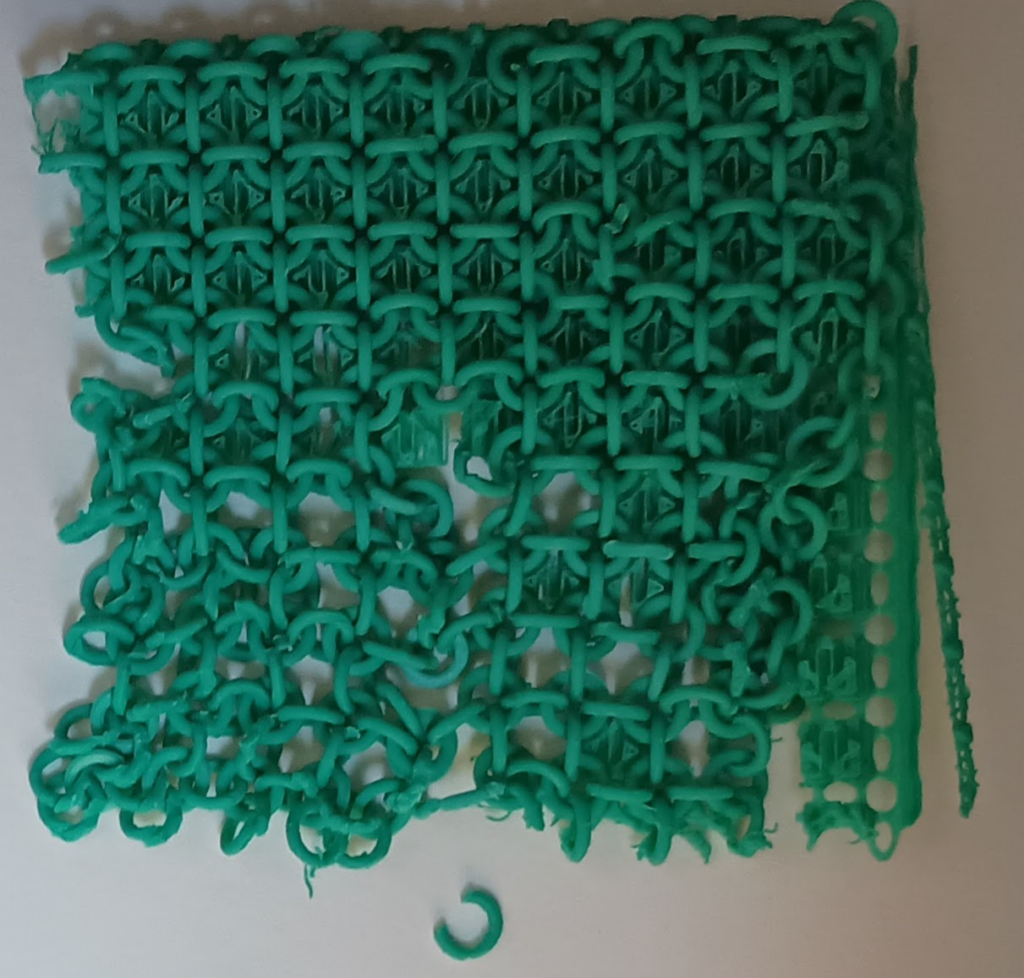Introduction
My project was to create a bag. I designed it with the use of fabricated textiles. I explored processes with GCODE, infill, chainmail, and printing on fabric. I created several swatches to showcase each method as well as the bag itself.

Background Research
https://dl-acm-org.libproxy.unm.edu/doi/pdf/10.1145/3379337.3415876 – This source explored creating DefeXtiles through GCODE under extrusion. This was particularly relavent to my own GCODE writing. I also created prints with variations in the extrusion rate.
https://www.researchgate.net/profile/Andrea-Ehrmann/publication/321228371_Effect_of_3D_printing_on_textile_fabric/links/5a1c723e4585153731890817/Effect-of-3D-printing-on-textile-fabric.pdf – This source reviewed the process of 3D printing on fabric. It included the effects of nozzle temperature, flow rate, extrusion width, and other effects on the final print. This was useful in my selection of a mesh fabric to work with.
https://repositories.lib.utexas.edu/server/api/core/bitstreams/c22a25ff-46da-477a-b09d-ab3ede4b5ab0/content – This source explored the design of 3D printed chainmail. This was helpful in the initial designs of my own chainmail patterns.
https://ieeexplore.ieee.org/abstract/document/9691798 – This source explores using GCODE to create weave patterns. I found this source when I was starting the project, but did not use any of these techiniques. I could imagine it being useful in a future exploration of a similar project.
Process
My process was to design swatches of each fabrication method, print test swatches, then connect some for a the final bag design.
GCODE: I wrote a program that had two support structures with a design inbetween created from different extrusion rates. I created a few patterns. I also wrote a program to take in a 2D curve drawn in Rhino and convert it to higher extrusion rates in the pattern. I did this process with both PLA and TPU.
INFILL: For this process, I changed the settings in Cura to only print the infill and none of the walls. Then I printed a shape that is 0.3 mm thick. This process was relatively simple and effective. In this process the leveling of the bed and cleanliness of it was much more important than on the other methods.
CHAINMAIL: I wrote a program to create a grid of links that could then be printed interlocked to form chainmail. I also created a hexagonal link that I used for chainmail as well.
PRINTING ON FABRIC: I created a grid of hexagonal extrusions. I used a mesh fabric. I would let it print a layer, then pause the print, then place the fabric over the top, and then have it resume printing. The result had the fabric sandwiched between the layers of the print.
CHALLENGES:
I had some issues after I scaled up the size of the fabricated swatches. When doing the GCODE method with the PLA filament I found that increasing the size of the swatch made it more brittle and resulted in cracking. When doing that method with the TPU filament (more flexible) it would fall over during printing because it did not have enough support. The infill method also had issues as it increased size in that it was more difficult to remove it from the bed resulting in tearing. When working with the chainmail I found that bigger swatches would start breaking mid print.




I had a few issues with my printer. When working with the TPU filament my nozzle clogged. I also had an issue where I would try and print a file I had already printed and the nozzle would move to the far corner and extrude without moving as it should. I am not sure what caused that issue but it managed to resolve.
I had some issues connecting the swatches I created. I did not leave enough time to handle this part of the project as I wasn’t expecting the other issues I encountered. I tried a few methods including interlocking the chainmail as it was printing, printing on either side of some fabric, printing a clip, printing a clasp, and having the nozzle stay still and extrude while I moved the pieces I wanted to connect underneath. Not all methods were successful and used in the final design.


Outcome
I was able to create a bag. I consider the bag more as a prototype of what could be done. It is a little messier and more fragile than I would have liked but I have no doubt that could be fixed given more time. The showcase of the different fabrication techniques is exactly what I wanted.
I wanted to test its ability to bear weight so put my wallet and keys inside. It was able to handle the weight. I will say, I wouldn’t trust this bag to hold all my things all day, but am satisfied with the demonstration.
Future Work
Like I said, I consider this bag a prototype. With more time it could be constructed cleaner and sturdier. It could also be constructed with inner pockets and other useful structures.
I would also want to explore what else I could do with the fabricated textiles I created for this project, e.g. clothing, belt, wallet, etc.
I also want to explore using TPU filament more. Unfortunately, it took a while for the roll of filament to arrive so I didn’t get a lot of time to experiment with it.
Reflection
I learned quite a few methods to fabricate textiles as part of this project. I got the chance to work more with GCODE. I quite enjoyed experimenting with the results and creating swatches. I also enjoyed working with the TPU filament and intend to explore that material more. I don’t imagine that I will use the bag I made much but do intend to make another iteration using what I learned during this project.
Code
Slides
https://docs.google.com/presentation/d/1f-EQK70boahdUQg95Md7tQ-LBFFoZbmB8_adAn4YgeM/edit?usp=sharing